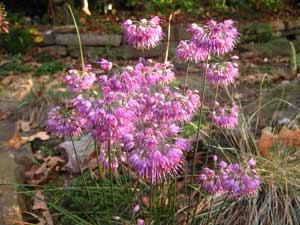Resource Library
Plant of the Week: Onion, Japanese Flowering
The University of Arkansas System Division of Agriculture does not promote, support or recommend plants featured in "Plant of the Week." Please consult your local Extension office for plants suitable for your region.
Plant of the Week
Japanese Flowering Onion
Latin: Allium thunbergii

Flowering bulbs were one of my first flirtations in gardening, and through the past almost five decades of studying plants, they remain favorites. While most bulbs reign supreme in the spring, a few come forth in the late summer and fall to offer up their beauty for the autumnal garden. The last bulb to bloom in the rock garden for me each year is the Japanese flowering onion, Allium thunbergii.
Japanese flowering onion is a clump-forming species reaching 12 to 15 inches tall when in bloom. It produces slender leaves that are longer than the flowering scape, but tends to relax on the ground by the time the blooms appear. The foliage is onion-scented, hollow and triangular at the base but flattening out to a 1/8th inch-wide blade near the tip. As frost hammers the planting, the foliage takes on an orange glow for a week or two before disappearing for the winter.
The flower buds appear in late summer on slender scapes, but for me, they remain closed until October. The terminal umbel is a lax, mop-head affair to about 2 1/2 inches across, and composed of many purple-pink blooms with six tepals and protruding stamens that look like so many eyelashes. Because the plant blooms so late, it has never produced seed in my garden.
I grow two plants under this name, but the cultivar ‘Ozawa’ is much showier than the seed-raised plant, which blooms a couple weeks earlier. ‘Ozawa’ is a more compact and floriferous introduction of George Schenk, a Washington-based nurseryman and garden writer best known for his books on shade gardens and moss gardening. He introduced the clone, presumably named after his Japanese source, prior to 1980. A dwarf form said to be half the size of ‘Ozawa’ is offered by some rock garden specialists but is probably a different species. Though described, I have never found a source for the white-flowered form.
Allium thunbergii is native to a wide swath of eastern Asia, including all of Japan, South Korea and parts of coastal China, where it occurs mostly at the forest edge. It honors Carl Peter Thunberg (1743-1828), a student of Linnaeus, who spent 1775 and 1776 mostly cloistered on the artificial island of Dejima in the bay of Nagasaki, Japan. Thunberg served as a medical doctor for the hundred or so Dutch traders and sailors stationed on the tightly controlled trading post. Many of the 300 or so new plants Thunberg collected while in Japan were plucked from the daily ration of hay delivered to the post to feed the animals. For a fictional account of life on Dejima during this period, check out David Mitchell’s The Thousand Autumns of Jacob De Zoet (Random House, 2010).
Japanese flowering onion is easy to grow in an average, well-drained site. My plants are in light shade, but they should do equally well in full sun. Bulbs are hardy from zones 5 through 9 and persist for years. Division is best done in late winter or early spring, but plants are tough enough that clumps can be divided in the growing season without much concern for plant survival. It is an ideal plant for the rock garden or other areas where an unexpected late season flash of color is desired.
By: Gerald Klingaman, retired
Retired Extension Horticulturist - Ornamentals
Extension News - August 26, 2011
The University of Arkansas System Division of Agriculture does not maintain lists of retail outlets where these plants can be purchased. Please check your local nursery or other retail outlets to ask about the availability of these plants for your growing area.